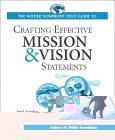The Wilder Nonprofit Field Guide to Crafting Effective Mission & Vision Statements
All too often if you ask four people who work for the same nonprofit what their organization's mission is, you'll get four different answers. The Wilder Nonprofit Field Guide to Crafting Effective Mission & Vision Statements is a brief how-to guide that outlines orderly, easy-to-follow steps that any nonprofit board can use to write these essential documents. The author argues that a good mission statement is a short, snappy description of the purpose of the organization — easy to fit in at the bottom of the organization's letterhead. It should be so memorable that it flows easily off the tongue of board, staff, and volunteers and so clear that the average person will understand the mission without further explanation or definition.
A vision statement, in contrast, paints a picture of the organization's desired future in a few paragraphs. It answers two questions: "What will be the difference in the world in three to five years because our organization exists? And, what role will our organization play in creating that difference?"
The Guide's focus on process provides a cornerstone to build ownership for the mission and vision statements among board members, staff, and other key stakeholders. By following the steps outlined in the book, an organization can create a common understanding of its goals.
The guide is divided into five sections:
An introduction explains why mission and vision statements are essential. Part I provides definitions for mission and vision statements, how to distinguish between the two, and ways to use both for maximum benefit. Part II outlines a seven-step process for developing a mission statement that captures what your organization accomplishes. Part III presents a six-step process that shows how stakeholders' ideas and organizational history act as catalysts for vision development. The Appendix includes worksheets to guide participants through the creation of both types of statements as well as a bibliography of other useful resources.
The author, Emil W. Angelica, is a senior consultant to the Amherst H. Wilder Foundation with more than two decades of experience in the nonprofit sector. His consulting background includes strategic planning, organizational and board development, fundraising planning, evaluation, and fiscal management.
This book is unique. Where other publications will often include a chapter on creating mission and vision statements, this is the first book I've seen that focuses solely on these topics. As such it is a fine addition to the literature for nonprofits.
For citations to additional reading on this topic, refer to Literature of the Nonprofit Sector Online, using the subject headings "Nonprofit organizations-mission statements" or use the Keyword phrase "vision statement*".









